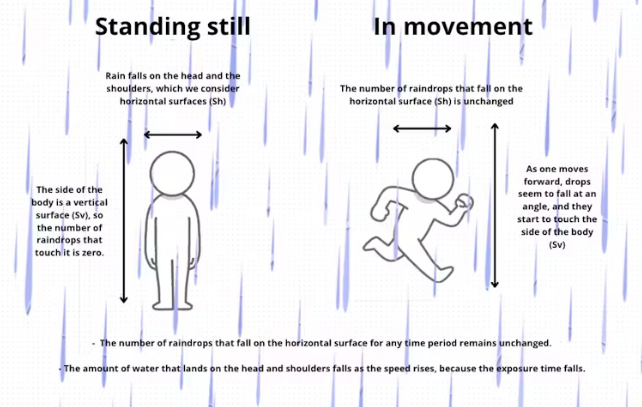ARTICLE AD
We've all been there – caught outside without an umbrella as the sky opens up. Whether it's a light drizzle or a heavy downpour, instinct tells us that running will minimise how wet we get. But is that really true? Let's take a scientific look at this common dilemma.
You're out and about, and it starts to rain – and naturally you've forgotten your umbrella. Instinctively, you lean forward and quicken your pace. We all tend to believe that moving faster means we'll spend less time getting wet, even if it means getting hit with more rain as we move forward.
But is this instinct actually correct? Can we build a simple model to find out if speeding up really reduces how wet we'll get? More specifically, does the amount of water that hits you depend on your speed? And is there an ideal speed that minimises the total water you encounter on your way from point A to point B?
Let's break it down while keeping the scenario simple. Imagine rain falling evenly and vertically. We can divide your body into two surfaces: those that are vertical (your front and back) and those that are horizontal (your head and shoulders).
When moving forward in the rain, vertical surfaces such as a person's body will be hit by more raindrops as speed increases. From the walker's perspective, the drops appear to fall at an angle, with a horizontal velocity equal to their own walking speed.
While walking faster means encountering more drops per second, it also reduces the time spent in the rain. As a result, the two effects balance each other out: more drops per unit of time, but less time in the rain overall.
When the walker is stationary, rain only falls on horizontal surfaces – the top of the head and shoulders. As the walker begins to move, she or he receives raindrops that would have fallen in front, while missing the drops that now fall behind. This creates a balance, and ultimately, the amount of rain received on horizontal surfaces remains unchanged, regardless of the walking speed.
However, since walking faster reduces the total time spent in the rain, the overall amount of water collected on horizontal surfaces will be less.
 When the skies open up, moving quickly affects where the raindrops hit you.
When the skies open up, moving quickly affects where the raindrops hit you.All in all, it's a good idea to pick up the pace when walking in the rain
For those who enjoy a mathematical approach, here's a breakdown:
Let ρ represent the number of drops per unit volume, and let a denote their vertical velocity. We'll denote Sh as the horizontal surface area of the individual (e.g., the head and shoulders) and Sv as the vertical surface area (e.g., the body).
When you're standing still, the rain only falls on the horizontal surface, Sh. This is the amount of water you'll receive on these areas.
Even if the rain falls vertically, from the perspective of a walker moving at speed v, it appears to fall obliquely, with the angle of the drops' trajectory depending on your speed.
During a time period T, a raindrop travels a distance of aT. Therefore, all raindrops within a shorter distance will reach the surface: these are the drops inside a cylinder with a base of Sh and a height of aT, which gives:
ρ.Sh.a.T.
As we have seen, as we move forward, the drops appear to be animated by an oblique velocity that results from the composition of velocity a and velocity v. The number of drops reaching Sh remains unchanged, since velocity v is horizontal and therefore parallel to Sh. However, the number of drops reaching surface Sv – which was previously zero when the walker was stationary – has now increased.
This is equal to the number of drops contained within a horizontal cylinder with a base area of Sv and a length of v.T. This length represents the horizontal distance the drops travel during this time interval.
In total, the walker receives a number of drops given by the expression:
ρ.(Sh.a + Sv.v). T
Now we need to take into account the time interval during which the walker is exposed to the rain. If you're covering a distance d at constant speed v, the time you spend walking is d/v. Plugging this into the equation, the total amount of water you encounter is:
ρ.(Sh.a + Sv.v). d/v = ρ.(Sh.a/v + Sv). d
This equation gives us two key insights:
The faster you move, the less water hits our head and shoulders. The water hitting the vertical part of your body stays the same regardless of speed, because the shorter time spent in the rain is offset by encountering more raindrops per second.To sum it all up: it's a good idea to lean forward and move quickly when you're caught in the rain. But careful: leaning forward increases Sh. To really stay drier, you'll need to increase your speed enough to compensate for this.![]()
Jacques Treiner, Physicien théoricien, Université Paris Cité
This article is republished from The Conversation under a Creative Commons license. Read the original article.

 1 month ago
24
1 month ago
24 

